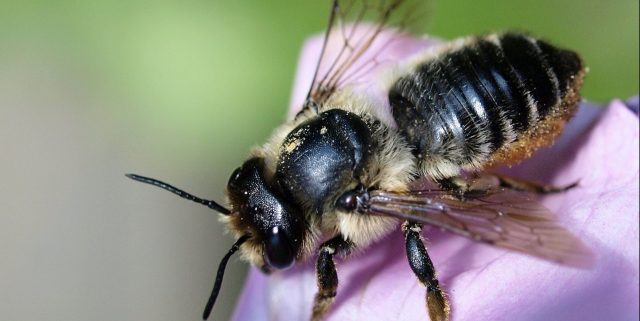04
Aug
Typical Neonicotinoid Insecticides at Any Level Likely to Kill Off Wild Pollinators

(Beyond Pesticides, August 4, 2021) Neonicotinoid insecticides applied to nursery plants sold at garden centers kill off wild, solitary pollinators regardless of the amount applied, according to research published in the Proceedings of the Royal Society B. The news is unlikely a surprise for those tracking the science around pollinator declines, but nonetheless a stark reminder of the lack of progress from federal regulators to stop practices that contribute to the ongoing crisis. With new science consistently showing unacceptable hazards to pollinator populations, advocates are urging Congress to take up and pass the Saving America’s Pollinators Act.
Since 2006, scientists and beekeepers have singled out neonicotinoids, a class of systemic insecticides, for their role in pollinator die-off and decline. Once applied onto a seed or sprayed on a plant, neonicotinoids distribute themselves throughout the plant’s structure. This causes soft-bodied sucking insects like aphids to be killed when they eat any part of the plant. However, neonicotinoids also make their way into the pollen and nectar the plant produces, as well as the dew drops plants will secrete and pollinators will often use to grab a quick drink.
The use of these insecticides on native plants sold at nursery stores throughout the country poses significant hazards to solitary, wild pollinators that rely on native flowing plants. To better understand how this practice harms these beneficial insects, researchers designed an experiment using the alfalfa leafcutter bee, a species native to Europe, but naturalized in the U.S. and often used as a stand-in to determine dangers to solitary bees in general. Scientists aimed to observe whether increasing irrigation watering amounts could avert the risks caused by the systemic nature of these chemicals by reducing the amount of neonicotinoid expressed in a plant’s nectar.
Flowering plants native to California (where the experiment was conducted) were purchased and distributed throughout 16 field cages, which were also each used to house 30 male and 20 female leafcutter bees. A control group of field cages received no exposure to a granular neonicotinoid product containing the insecticide imidacloprid, while the rest were split between a high irrigation and low irrigation group, and had imidacloprid applied at only 30% of its recommended label rate. Although not recorded in the study, a press release published by University of California, Riverside indicates that the first time the experiment was tried, researchers used the EPA recommended label concentration of the product, and all bees died within a few short days.
At the significantly lower rate, scientists found that high irrigation watering reduced the amount of imidacloprid detected in plant nectar. Nonetheless, researchers observed the same harmful effects on leafcutter bes as the group exposed to lower amounts of irrigation. “Neonicotinoids are often used on food crops as a seed treatment,” says study author Jacob Cecala. “But they’re usually applied in higher amounts to ornamental plants for aesthetic reasons. The effects are deadly no matter how much the plants are watered.”
Although bees did not die outright like the high dose experiment, “It almost completely wiped them out,” Dr. Cecala notes. Changes were observed to bee’s overall fitness, including the ability to feed themselves. The number of brood cells created by the neonicotinoid-treated group was a mere 5% of the unexposed control group.
Scientists indicate that the leaf clipping behavior of alfalfa leafcutter bees may play a role in increasing exposure to the pesticide. However, previous research shows that other solitary, wild pollinators have ecological roles that would increase their chemical exposure. Close contact with soil, for instance, puts ground nesting bees at increased risk of chronic exposure. Wild bees have been found to be particularly vulnerable to neonicotinoids. A study published in March 2021 finds that another, the hoary squash bee, which digs its home underground, initiates 85% fewer nests, harvests 5 times less pollen, and produces 89% fewer offspring than squash bees not exposed to neonicotinoids.
Science has long shown that neonicotinoids present hazards to pollinators at incredibly low doses. In 2014, a study found that “near-infinitesimal doses” of neonicotinoids hindered the ability for bumblebees to gather food. Moreover, a 2019 study found that in general, the toxicity of insecticides used in agriculture in the U.S. increased by a factor of roughly 4 to 48 since 1992. Not only are these chemicals ineffective at controlling problem pests, as studies commissioned by EPA have found, the nontarget impacts to beneficial pollinators and other wildlife provide cause to immediately ban the entire neonicotinoid class of insecticides.
Channel your outrage about the plight of pollinators towards decisionmakers that permit hazardous pesticide use to continue. Urge your Congressional Representative to cosponsor the Saving America’s Pollinators Act, which would work to truly unwind the pollinator crisis by eliminating toxic pesticides and putting pollinator experts, without pesticide industry conflicts of interest, in charge of their long-term health. For more information, including advice on how to engage with this important issue, visit Beyond Pesticides Bee Protective program page.
All unattributed positions and opinions in this piece are those of Beyond Pesticides.
Source: UC Riverside Press Release, Proceedings of the Royal Society B










